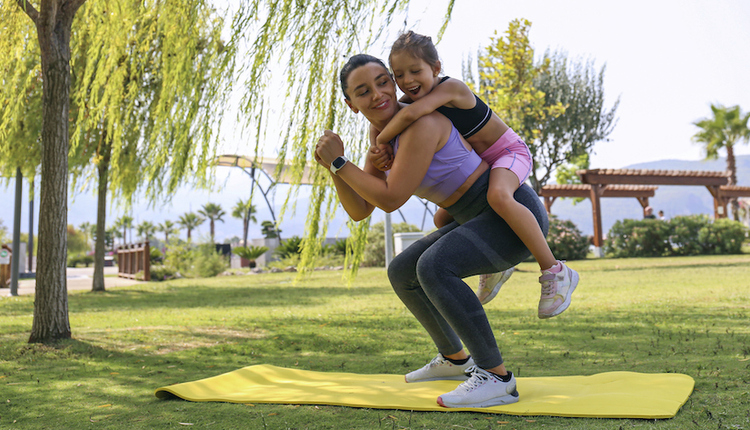Whenever I come into contact with a coach or trainer who preaches the virtues of machine-based strength training for young athletes, the same argument is typically offered: machines are safer for kids because they eliminate the dangerous aspects of traditional free-weight training. This is simply a dogmatic mindset and not founded on any scientific or functional principles, and it is a classic case of blaming the exercise or activity rather than the execution. In fact, having young athletes train on machines can lead to injuries and a whole host of other concerning factors.
Machine Training Issues
All sports are dynamic and require a great deal of systemic strength and stability to perform. Moreover, the strength/stability interplay needed to perform virtually any sporting activity is based on the body working as a unit — the way nature intended. By isolating certain muscle groups via machine training, you are eliminating the body's natural capacity to provide both mobility and stability in an interrelated manner. This can limit a young athlete's ability to effectively produce force on the field of play while providing stability in other crucial areas of the body. By disturbing this innate mobility/stability balance, you are decreasing the body's ability to protect itself during the dynamic and unscripted movements experienced in sports. Coaches and trainers who incorporate machine-based training into the routines of young athletes in order to promote weight room safety are increasing the risk of injury on the field of play. One of the primary goals of a sound strength and conditioning program is to prevent injuries during a sporting event or season — so those who insist on using machines for training are suggesting that trading sport safety for weight room safety is somehow a good deal.
Here is a look at some of the finer points of machine training:
· Seated vertical pressing machines place a great deal of stress on the lumbar spine, more so than standing vertical pressing exercises. In order to press as much weight as possible, athletes will actively hyper-extend the lower lumbar to gain extra leverage.
· Seated leg press machines do not afford backrests that equal the spine's natural curvatures. Additionally, many young athletes tend to overload seated leg presses with extreme amounts of weight. At increased loads during the eccentric or lowering phase, the lower lumbar will go through a forced flexion, a terribly unstable position for one's lower back to be in.
· Hack-squat machines can place a great deal of anterior shearing forces on the knee joint. They tend to primarily work the quadricep muscles and are less effective at training the critical hip extensor muscles of the posterior chain.
· Hip abduction and abduction machines allow minor to excessive spinal rotation. As you try to isolate a hip abduction exercise, you will naturally "shift" away from the leg in motion and experience spinal rotation. Due to the body's natural habits of motion, it is impossible to isolate a movement or muscle without experiencing stabilization dynamics in other parts of the body.
· Smith machines allow for vertical motion only, which is contraindicated in exercises such as the squat, an exercise that many young athletes perform on the Smith machine. In good squatting form, there should be a natural forward lean while the hips are pushing back. This allows one to maintain a sound neutral lumbar spine position and actively generate force from the powerful hip extensor muscles. With Smith machines, this motion is eliminated completely, and lumbar flexion is promoted.
· In many cases, coaches and trainers use machines in a circuit type fashion and route several young athletes at a time through a machine-to-machine type routine. Whenever young athletes are working on timed events (i.e. the coach allows for 20-40 seconds at each station), you can be assured that the athlete is attempting to get as many "high intensity" reps out of his/her set as possible, often at the complete disregard of their execution. With machine or free-weight strength training, perfect execution is a must — in a sense, that makes machines and free weights equal in this argument. Having said that, the very unnatural nature of machines make them even more of a concern from a biomechanical safety perspective with respect to "timed" training sessions or sets.
Proprioceptive Neuromuscular Facilitation
Functionality in both sport and life is based on healthy movement, certainly not isolation. In that, Proprioceptive Neuromuscular Facilitation (PNF) plays a vital role. Often noted as a type of stretching exercise, PNF is actually a diverse and intensive concept that involves movement-based stimulus following spiral or diagonal motions (to reflect that oblique nature of most muscle orientations), with the primary goal of developing motor learning through precise movements. With that in mind, machine-based strength training, with its isolated format, is simply not functionally similar to innate patterns of motion that a young athlete would use on the field of play and is quite disruptive to basic physiological factors of movement, such as normal timing (which refers to the naturally occurring timing of the phases of movement during a given motion).
Disadvantages of Stationary Bikes and Treadmills
Even with cardiovascular training, it is less than optimally productive to have young athletes use either the stationary bikes or treadmills found in most health clubs. Possessing optimal speed, agility or any other reactive locomotor ability is based largely on hip and trunk flexibility and strength. Both cycling and treadmill running serve to limit hip range of motion and can cause decreases in the dynamic flexibility within the hip complex. Young athletes are better served to incorporate rigorous sprinting or movement-base interval training (such as Fartlek) into their training routines.
It is a gross misappropriation of human anatomy and movement science to suggest that children and inexperienced weightlifters should begin an exercise program centered on fitness machines. Falsely considered a "safer" form of exercise for unseasoned fitness enthusiasts, weight training machines, along with their cardiovascular counterparts, are actually far too restrictive and interruptive of normal body mechanics to be deemed anything other than potential injury evokers. With children, youths and teenagers, you must teach multi-planar and multi-directional strength and movement — this is the essence of human motion and a requirement when working with this sensitive demographic.
Brian Grasso currently serves as CEO for the International Youth Conditioning Association and is a sought-after expert in the realm of young athlete development and youth fitness worldwide. He presents educational seminars to personal trainers and coaches throughout North America, Europe and the Pacific Rim. For more information, check out Brian's ground-breaking Free ResourceCenter at www.DevelopingAthletics.com.
Jan. 14 2008















